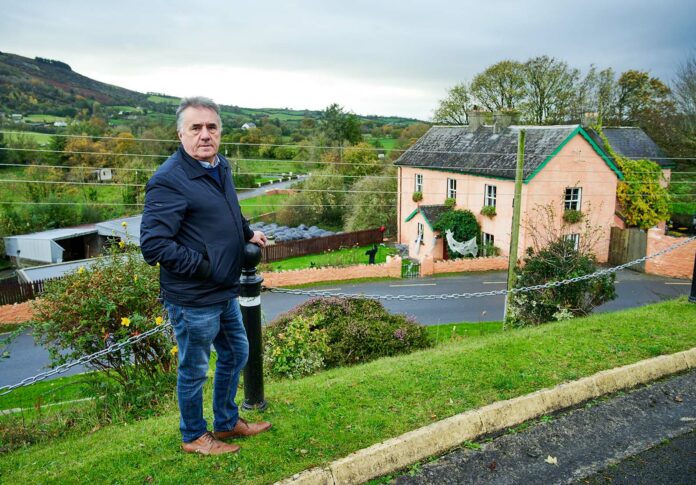A RETIRED South-East Clare primary school teacher has provided a wealth of information for future generations about his native place in a new local history book.
Broadford parish is a consequence of its colourful history, which Pat O’Brien (68) felt should be recognised and celebrated.
Broadford Parish 1800-1850 – ‘The History of a Rural County Clare Parish During an Eventful Time’ comprises 650 pages, illustrated with images particularly of local significance.
The book, which is an expensive undertaking, is published by his wife, Caroline O’Brien, The Celtic Bookshop, 2 Rutland Street, Limerick City, on high quality paper and is issued in an edition of 300 hardbound copies, with dust wrappers.
Growing up in this special place, Pat developed an abiding interest in its history and lore. He has written this book in an attempt to discover what life was like for people living in Broadford parish during the first half of the nineteenth century, a traumatic period in both national and local history.
Relative to the millennia of human occupation of this landscape, 1800-1850 is a recent era, yet it has remained a “hidden” time.
Despite the enormously significant developments that occurred in the community at this time, they have never previously been published.
In this book, Pat explored what life was like for people of all classes, who lived in Broadford parish during the period, breaking the great silence of that generation.
Rather than listing the significant events that occurred, Pat provides a historical context for them so the reader can easily understand the information that is being provided.
The uniquely detailed book covers many topics including; the ownership and occupation of land; local landlords and their power and influence; significant national developments including how the Tithe War and Catholic Emancipation impacted on Broadford parish; the foundation of the local national schools and the important role played by the Catholic Church in the life of the parishioners.
Other areas covered include tenants and tenancy arrangements; religious affiliations; crime and punishment; famine and emigration; the role of women; social economic and cultural life; public works and the Irish language.
Born in Ardskeagh on the upper road from Broadford to Kilbane, Pat was one of a large family of nine children.
He grew up close to the Mill field where the first senior hurling championship final was played, near the slate quarries, which Broadford was famous for and was reared in a house where a lot of visitors and friends outlined stories about previous generations and the yellow haired witch of Broadford.
“I became engrossed with the local history of the parish,” said Pat.
“I have spent decades researching archives all over Ireland and England online and printed material in newspapers.
“Broadford is one of the most historic parishes in the county. It was a very large parish with 20,000 acres of land. It had a huge population and was central to the politics and religion in East Clare.
“If someone was travelling from Ennis to Dublin or Tulla to Limerick in 1830, you went through Broadford. It was a very important centre.
“There is a huge amount of material relating to Broadford in existence in the archives. There were three RIC barracks in the parish – one in Broadford, one in Kilbane and one on the road from Broadford to Limerick to protect the road.
“I got information from the State Bentley Papers and a fabulous journal from Mary Going, Violet Hill, who was a Church of Ireland member who recorded details you wouldn’t have got elsewhere about cricket being played in Broadford in 1840s. The Arthurs from Glenomra, a hugely important landlord merchant family who came from Limerick and had an enormous estate. There was a population in excess of 8,000 people. I had an enormous amount of material to work from,” he said.
He believes this 50-year period was a time of great change in Broadford. Three national schools were established in Broadford, Kilbane and Woodfield and three Catholic Churches were built and the post office and transport came during this time.
In fact, people could travel via Bianconi coach from Limerick to Broadford to Tulla daily and back to Limerick compared to the current once a week return service from Broadford to Limerick on a Saturday.
Broadford Post Office, which closed a few years ago, was a major postal centre in this period, as it was a major hub for East Clare radiating out to Bodyke, Feakle and Scariff.
The slate quarry was a hive of activity at the time aslo.
With the population of Broadford increasing significantly from 5,000 around 1800 to 8,200 before the Famine, this half century really fascinated the author.
The book is the culmination of exhaustive research or multiple sources of information spanning a 30-year period during the author’s spare time.
“I loved the research. I loved going into the National Library looking for the Arthur manuscripts expecting a small box and finding two large metal casts of landed gentry details to examine.
“I would have never have completed the book only for my sons Aidan, Aonghus and Peter, who felt it would be a waste of time if there wasn’t a product at the end. They contacted the printer, preparing photographs and layout. I did all the research and writing, but without their input, the book wouldn’t have happened,” he admitted.
His education included Broadford National School, St Joseph’s Secondary School, Tulla, third-level college in Galway and an MA in Local History in University of Limerick, where he has lectured on sources of local history.
Most of his 40-year stint as a primary school teacher was spent in Kilkishen National School, which he thoroughly enjoyed.
Being involved in Broadford Hurling Club as a player, officer and supporter has been a huge part of his life.
Since his retirement, he works for his wife, Caroline, in Celtic Bookshop in Limerick City, which she opened in 1995. He loves meeting people and sharing his love of history and folklore with customers.
East Clare correspondent, Dan Danaher is a journalism graduate of Rathmines and UL. He has won numerous awards for special investigations on health, justice, environment, and reports on news, agriculture, disability, mental health and community.


